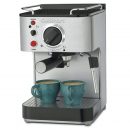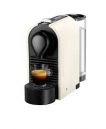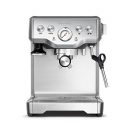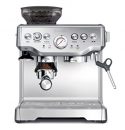
Introduction to the French Press
The concept of the French Press was born in the mid-1800s in France when Mayer and Delforge were granted the first patent for their invention. The idea according to the inventors was to push a rod into a cylindrical container to get filtered coffee above the piston that was absolutely clear. Also known as the coffee press, plunger pot, press pot or cafeteire, the French Press has come a long way since its humble beginnings.
The French Press method of preparing coffee extracts the full, concentrated flavours of the beans in their purest form. The steeping method by which the coffee grinds stay in contact with water throughout the brewing time in a French Press and then the squeezing of the grinds at the bottom of the container while the favours and oils are allowed to seep through the holes of the plunger deliver a more complex flavour in your cup of Joe.
In other methods of making coffee like an automatic coffee machine, many of the oils along with the flavours get absorbed into the filter paper and plastic body of the machine. Over time they collect in the various nooks and crannies of the machine and eventually contribute a stale, burned taste of the coffee. The construction of the French Press is such that there are no crevices for residue to collect, so year after year, every pot you make is always fresh and without the burned after taste.
A typical press is made up of a cylindrical vessel that may be glass, steel or plastic with a firmly fitting plunger. A screen that is used to push the coffee grounds to the end of the vessel is fitted below the plunger. The design of the French Press is highly adaptable perhaps that is why they can be purchased in such a large variety of forms, everything from portable French Press mugs to highly elaborate models are available.
How to Use a French Press:
It is important to remember that coffee brewed in the French Press is intended to be consumed as soon as it is brewed. Even after being pushed to the bottom, the grinds continue to interact with the water and if extraction is protracted for extended period of time it alters the flavour of the coffee. If you wish to drink your coffee after some time, then it is better to decant it in a thermal cup after brewing.
Grind size: The size of the coffee particles is exceptionally important to this method of brewing. If the grounds are very fine, they will escape through the holes in the plunger and produce muddy coffee. Additionally, the increased surface area that is obtained as particle size is made smaller will speed up extraction and if you are not very careful, chances are that you will end up with bitter coffee every time.
Amount of Coffee Grinds: If you are a new user of the French Press, it is recommended that you begin by using 1 to 2 teaspoons (depending if you prefer strong or weaker drink) of coffee grounds for an 8 oz. serving. This is a good starting point and later you can make adjustments according to what serves your palate the best.
Temperature of Water: Water that is just below the boiling temperature is ideal for use in a French Press; however this too is a variable that can be adjusted according to taste. To start with bring water to a boil and allow it to sit for about 40 seconds before pouring it into the press. This should bring the temperature to roughly 90° Celsius (195° F) which is ideal for this brewing method.
Brew Time: This is another adaptable aspect that can be toyed with until you find what suits your personal preference. The brew time can be anywhere between three to five minutes. However if a dark roast is selected then five minutes may prove to be too much while three minutes for a light roast may not be sufficient. Starting with a four minute brew time is reasonably safe.
Tips for Brewing the Perfect Cup
Start the brewing by first preheating the carafe. This is done by adding about half a cup out of the water you boiled for brewing to the empty flask and gently twirling it around to heat all parts of the carafe. Discard this water. Next add the desired amount of coffee grinds to the carafe and top off with enough water to saturate all the grounds. Allow to rest for about thirty seconds. Stir the contents gently, add the remaining water and allow steeping for four minutes. Now it is time to plunge and enjoy the brew!
- If you find the plunging to slide with too much ease chances are that your coffee grind size is too coarse, on the other hand if plunging is hard than the coffee size is too fine.
- Keeping your machine parts spick and span is very important to taste of the coffee. Cleaning the carafe is fairly easy; however make sure to clean the filter well as grinds stuck here will be the most dangerous enemy of your next cup. Majority of the filters can be taken apart for cleaning purposes.
Best Stainless Steel French Press
Traditional French Presses were typically made of glass. The glass presses serve you well if you are going to drink the coffee immediately, and they allow you to view the magic happening inside the carafe. However, glass cools fairly quickly, and you can’t savour the brew made in a glass carafe, later. For this the stainless steel press pots are better suited.
Stainless steel is an inert material; it does not react with the coffee being brewed and add its own metallic taste like some other metals. An additional benefit is that it is good at retaining heat. There are many excellent Stainless French Presses available in the market. A couple are reviewed here.
Frieling Polished 18/10 Stainless Steel French Press
This press is among the most costly available, yet a favourite of coffee connoisseurs anywhere. It is constructed of stainless steel throughout, inclusive of the double-walled carafe, plunger and filters housed within. The double-wall assembly keeps drinks comfortably hot for well over an hour. The handle is snug enough to provide stability when pouring and protects the hand against heat. The spring-loaded plunger fits tightly against the inner wall while the mesh filter glides smoothly through the brew stopping short of hitting bottom, to allow for final extraction from the used coffee grounds. The unit is completely dishwasher safe and the filter can be taken apart for ease of cleaning. The Frieling 18/10 stainless steel press will set you back around a hundred dollars. However, it is durable and will provide years of service unlike the glass carafes which requires regular and frequent replacements.
The Francois et Mimi Double Wall French Press
This is another good all stainless steel French Press. It comes with a lid that locks in position for safe pouring without any danger of unexpected spills. It has excellent heat retention due to the double walled construction. While elegantly designed, it lacks the exterior mirror polish of the Frieling press. Some of the users find the hollow lid to be a bit of an issue when it comes to cleaning. Also the filter assembly can’t be dismantled completely which is another maintenance challenge. Considering the fact that it costs about 1/3 the price of the Frieling Polished 18/10 Stainless Steel French Press, and delivers an excellent cup of coffee, it is an excellent product.











